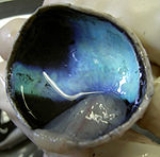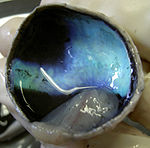
Choroid
Encyclopedia
The choroid, also known as the choroidea or choroid coat, is the vascular
layer of the eye, containing connective tissue
, and lying between the retina
and the sclera
. The human choroid is thickest at the far extreme rear of the eye (at 0.2 mm), while in the outlying areas it narrows to 0.1 mm. The choroid provides oxygen
and nourishment to the outer layers of the retina
. Along with the ciliary body
and iris
, the choroid forms the uveal tract.
The structure of the choroid is generally divided into four layers:
, originating from the ophthalmic artery
. The arteries of the uveal circulation, supplying the uvea and outer and middle layers of the retina, are branches of the ophthalmic artery and enter the eyeball without passing with the optic nerve. The retinal circulation, on the other hand, derives its circulation from the central retinal artery, also a branch of the ophthalmic artery, but passing in conjunction with the optic nerve. They are branching in a segmental distribution to the end arterioles and not anastomoses. This is clinically significant for diseases affecting choroidal blood supply. The macula
responsible for central vision and the anterior part of the optic nerve
are dependent on choroidal blood supply.
 Melanin
Melanin
, a darkly colored pigment
, helps the choroid limit uncontrolled reflection within the eye that would potentially result in the perception of confusing images. In humans and most other primates, melanin occurs throughout the choroid. In albino humans, frequently melanin is absent and vision is low
. In many animals, however, the partial absence of melanin contributes to superior night vision
. In these animals, melanin is absent from a section of the choroid and within that section a layer of highly reflective tissue, the tapetum lucidum
, helps to collect light by reflecting it in a controlled manner. The uncontrolled reflection of light from dark choroid produces the photographic red-eye effect
on photos, whereas the controlled reflection of light from the tapetum lucidum produces eyeshine (see Tapetum lucidum
).
Blood vessel
The blood vessels are the part of the circulatory system that transports blood throughout the body. There are three major types of blood vessels: the arteries, which carry the blood away from the heart; the capillaries, which enable the actual exchange of water and chemicals between the blood and...
layer of the eye, containing connective tissue
Connective tissue
"Connective tissue" is a fibrous tissue. It is one of the four traditional classes of tissues . Connective Tissue is found throughout the body.In fact the whole framework of the skeleton and the different specialized connective tissues from the crown of the head to the toes determine the form of...
, and lying between the retina
Retina
The vertebrate retina is a light-sensitive tissue lining the inner surface of the eye. The optics of the eye create an image of the visual world on the retina, which serves much the same function as the film in a camera. Light striking the retina initiates a cascade of chemical and electrical...
and the sclera
Sclera
The sclera , also known as the white or white of the eye, is the opaque , fibrous, protective, outer layer of the eye containing collagen and elastic fiber. In the development of the embryo, the sclera is derived from the neural crest...
. The human choroid is thickest at the far extreme rear of the eye (at 0.2 mm), while in the outlying areas it narrows to 0.1 mm. The choroid provides oxygen
Oxygen
Oxygen is the element with atomic number 8 and represented by the symbol O. Its name derives from the Greek roots ὀξύς and -γενής , because at the time of naming, it was mistakenly thought that all acids required oxygen in their composition...
and nourishment to the outer layers of the retina
Retina
The vertebrate retina is a light-sensitive tissue lining the inner surface of the eye. The optics of the eye create an image of the visual world on the retina, which serves much the same function as the film in a camera. Light striking the retina initiates a cascade of chemical and electrical...
. Along with the ciliary body
Ciliary body
The ciliary body is the circumferential tissue inside the eye composed of the ciliary muscle and ciliary processes. It is triangular in horizontal section and is coated by a double layer, the ciliary epithelium. This epithelium produces the aqueous humor. The inner layer is transparent and covers...
and iris
Iris (anatomy)
The iris is a thin, circular structure in the eye, responsible for controlling the diameter and size of the pupils and thus the amount of light reaching the retina. "Eye color" is the color of the iris, which can be green, blue, or brown. In some cases it can be hazel , grey, violet, or even pink...
, the choroid forms the uveal tract.
The structure of the choroid is generally divided into four layers:
- Haller's layer - outermost layer of the choroid consisting of larger diameter blood vessels;
- Sattler's layerSattler's layerSattler's layer is layer of medium-diameter blood vessels of the choroid, a layer of the eye....
- layer of medium diameter blood vessels; - ChoriocapillarisChoriocapillarisThe capillary lamina of choroid or choriocapillaris is a layer of capillaries that is immediately adjacent to Bruch's membrane in the choroid....
- layer of capillaries; and - Bruch's membraneBruch's membraneBruch's membrane is the innermost layer of the choroid. It is also called the vitreous lamina, because of its glassy microscopic appearance.It is 2–4 μm thick.-Layers:Bruch's membrane consists of five layers :...
(synonyms: Lamina basalis, Complexus basalis, Lamina vitra) - innermost layer of the choroid.
Blood supply
There are two circulations of the eye: the retinal and uveal, supplied in humans by posterior ciliary arteriesCiliary arteries
The ciliary arteries are divisible into three groups, the long posterior, short posterior, and the anterior.* The short posterior ciliary arteries from six to twelve in number, arise from the ophthalmic as it crosses the optic nerve....
, originating from the ophthalmic artery
Ophthalmic artery
The ophthalmic artery is the first branch of the internal carotid artery distal to the cavernous sinus. Branches of the OA supply all the structures in the orbit as well as some structures in the nose, face and meninges...
. The arteries of the uveal circulation, supplying the uvea and outer and middle layers of the retina, are branches of the ophthalmic artery and enter the eyeball without passing with the optic nerve. The retinal circulation, on the other hand, derives its circulation from the central retinal artery, also a branch of the ophthalmic artery, but passing in conjunction with the optic nerve. They are branching in a segmental distribution to the end arterioles and not anastomoses. This is clinically significant for diseases affecting choroidal blood supply. The macula
Macula
The macula or macula lutea is an oval-shaped highly pigmented yellow spot near the center of the retina of the human eye. It has a diameter of around 5 mm and is often histologically defined as having two or more layers of ganglion cells...
responsible for central vision and the anterior part of the optic nerve
Optic nerve
The optic nerve, also called cranial nerve 2, transmits visual information from the retina to the brain. Derived from the embryonic retinal ganglion cell, a diverticulum located in the diencephalon, the optic nerve doesn't regenerate after transection.-Anatomy:The optic nerve is the second of...
are dependent on choroidal blood supply.
In bony fish
Teleosts bear a body of capillary adjacent to the optic nerve called the choroidal gland. Though its function is not known, it is believed to be a supplemental oxygen carrier.Mechanism

Melanin
Melanin is a pigment that is ubiquitous in nature, being found in most organisms . In animals melanin pigments are derivatives of the amino acid tyrosine. The most common form of biological melanin is eumelanin, a brown-black polymer of dihydroxyindole carboxylic acids, and their reduced forms...
, a darkly colored pigment
Pigment
A pigment is a material that changes the color of reflected or transmitted light as the result of wavelength-selective absorption. This physical process differs from fluorescence, phosphorescence, and other forms of luminescence, in which a material emits light.Many materials selectively absorb...
, helps the choroid limit uncontrolled reflection within the eye that would potentially result in the perception of confusing images. In humans and most other primates, melanin occurs throughout the choroid. In albino humans, frequently melanin is absent and vision is low
Low vision
Low vision is a subspecialty within the professions of optometry and ophthalmology dealing with individuals who have reduced vision even when using the best possible spectacle or contact lens correction available. It can be a result of either congenital disease Low vision is a subspecialty within...
. In many animals, however, the partial absence of melanin contributes to superior night vision
Night vision
Night vision is the ability to see in low light conditions. Whether by biological or technological means, night vision is made possible by a combination of two approaches: sufficient spectral range, and sufficient intensity range...
. In these animals, melanin is absent from a section of the choroid and within that section a layer of highly reflective tissue, the tapetum lucidum
Tapetum lucidum
The tapetum lucidum is a layer of tissue in the eye of many vertebrate animals....
, helps to collect light by reflecting it in a controlled manner. The uncontrolled reflection of light from dark choroid produces the photographic red-eye effect
Red-eye effect
The red-eye effect in photography is the common appearance of red pupils in color photographs of eyes. It occurs when using a photographic flash very close to the camera lens , in ambient low light. The effect appears in the eyes of humans and animals that have no tapetum lucidum, hence no...
on photos, whereas the controlled reflection of light from the tapetum lucidum produces eyeshine (see Tapetum lucidum
Tapetum lucidum
The tapetum lucidum is a layer of tissue in the eye of many vertebrate animals....
).

